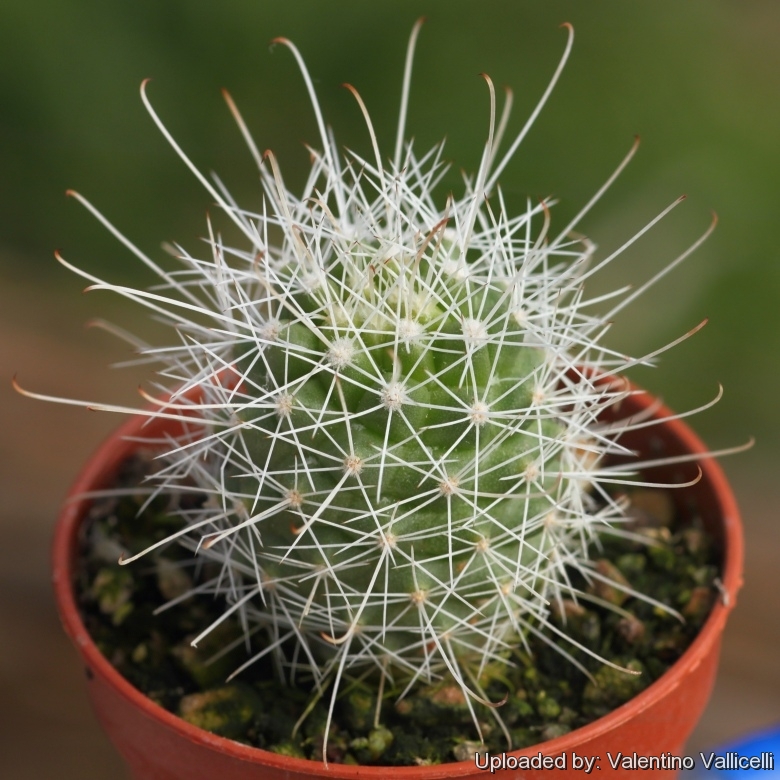Accepted Scientific Name: Cochemiea pondii subs. setispina (J.M.Coult.) U.Guzmán
Cactaceae Syst. Init. 16: 16 (11 Oct. 2003) Remarks: first published in U.Guzmán et al., Catálogo Cact. Mex.: 33 (May 2003), without basionym reference

Mammillaria pondii subs. setispina (Cochemiea pondii subs. setispina) Photo by: Valentino Vallicelli
Origin and Habitat: Cochemiea pondiiSN|9642]]SN|9642]] subsp. setispina is endemic to Mexico in the interior of Baja California, (San Borja region, San Julio Canyon, and Angel de la Guarda Island )
Type locality: San Borgia, Baja California, Mexico.
Altitude: 0-400 m
Habitat: It grows on the slope of granite mountains, on gravelly or sandy ground with gneiss, trachyt, porphur, and in a sandstone conglomerate together with Echinocereus ferreirianusSN|7509]]SN|21825]], Echinocereus sanborgianusSN|21825]]SN|7509]], Mammillaria dioicaSN|916]]SN|916]] and Ferocactus peninsulaeSN|11977]]SN|11977]].
Synonyms:
See all synonyms of Cochemiea pondii
back
Accepted name in llifle Database:Cochemiea pondii (Greene) WaltonCact. J. (London) 2: 51. 1899 , in obs.Synonymy: 3
Accepted name in llifle Database:Cochemiea pondii subs. maritima (G.E.Linds.) U.GuzmánCactaceae Syst. Init. 16: 16 (11 Oct. 2003) first published in U.Guzmán et al., Catálogo Cact. Mex.: 33 (May 2003), without basionym referenceSynonymy: 4
Accepted name in llifle Database:Cochemiea pondii subs. setispina (J.M.Coult.) U.GuzmánCactaceae Syst. Init. 16: 16 (11 Oct. 2003) Remarks: first published in U.Guzmán et al., Catálogo Cact. Mex.: 33 (May 2003), without basionym referenceSynonymy: 5
back
Description: Cochemiea pondiiSN|9642]]SN|9642]] subsp. setispina (syn: Mammillaria setispinaSN|9647]]SN|9647]]) is a local form of Cochemiea pondiiSN|9642]]SN|9642]] distinguished from the type species for having only 1-4 central spines, of which the upper one straight, lower one longest and hooked, 2-5 cm long. The flowers are very showy, long, red, narrowly tubular with bilateral symmetry and fit for hummingbird pollination.
Habit: It is a small cereus like cactus, at first solitary then with time forming small irregular few branched clusters, with stems, either ascending or prostrate, somewhat jointed hidden under a dense cover of spines.
Stems: Ascending, 30 cm high.
Roots: Fibrous or moderately thickened.
Tubercles: Short; axils of tubercles woolly but not setose.
Radial spines: 10 to 12, white with black tips, widely spreading, unequal, 10 to 34 mm long, slender.
Central spines: 1 to 4, stouter than the radials, one of them pointing downwards strongly hooked, 2-5 cm long.
Flowers: Large, produced near the plants tip from axils of tubercles, scarlet, 5 cm long, 2 cm wide, zygomorphic with a long hypanthium, segment flaring and tips reflexed.
Fruit:Obovoid, 3 cm long, scarlet.
Blooming season: March – April (sometime blooms a second time in Autumn)
Seeds: Black and pitted.
Subspecies, varieties, forms and cultivars of plants belonging to the Cochemiea pondii group
 Cochemiea pondii (Greene) Walton: (subsp. pondii) has 4-11 central spines up to 30 mm long, reddish, longer and stouter than the radials, of which one (or two) rigid and strongly hooked. Distribution: Cedros Island, off the Pacific coast of Baja California, Mexico.
Cochemiea pondii (Greene) Walton: (subsp. pondii) has 4-11 central spines up to 30 mm long, reddish, longer and stouter than the radials, of which one (or two) rigid and strongly hooked. Distribution: Cedros Island, off the Pacific coast of Baja California, Mexico. Cochemiea pondii subs. maritima (G.E.Linds.) U.Guzmán: has usually only four central spines the lowermost stronger, longer and hooked 3 – 5 cm long. Distribution: Pacific coast of the peninsula Baja California ( from Punta blanca to punta rosalia, west of Punta prieta)
Cochemiea pondii subs. maritima (G.E.Linds.) U.Guzmán: has usually only four central spines the lowermost stronger, longer and hooked 3 – 5 cm long. Distribution: Pacific coast of the peninsula Baja California ( from Punta blanca to punta rosalia, west of Punta prieta) Cochemiea pondii subs. setispina (J.M.Coult.) U.Guzmán: has only 1-4 central spines, upper one straight, lower one longest and hooked, 2-5 cm long. Distributiom: San Borja region, San Julio Canyon, and Angel de la Guarda Island, Baja California.
Cochemiea pondii subs. setispina (J.M.Coult.) U.Guzmán: has only 1-4 central spines, upper one straight, lower one longest and hooked, 2-5 cm long. Distributiom: San Borja region, San Julio Canyon, and Angel de la Guarda Island, Baja California.
Bibliography: Major references and further lectures
1) Pilbeam J., “The Cactus file, Mammillaria” 6: 120, Cirio Pub. Services, 01/Dec/1999
2) John Pilbeam “Cacti for the Connoisseur: A Guide for Growers & Collectors” Timber Press, 01/lug/1987
3) James Cullen, Sabina G. Knees, H. Suzanne Cubey "The European Garden Flora Flowering Plants: A Manual for the Identification of Plants Cultivated in Europe, Both Out-of-Doors and Under Glass" Cambridge University Press, 11/Aug/2011
2) David R Hunt; Nigel P Taylor; Graham Charles; International Cactaceae Systematics Group. "The New Cactus Lexicon" dh books, 2006
3) Edward Anderson “The Cactus family” Timber Press, Incorporated, 2001
5) N. L. Britton, J. N. Rose “The Cactaceae. Descriptions and Illustrations of Plants of the Cactus Family.” Volume 4, The Carnegie Institution of Washington, Washington 1923
Cultivation and Propagation: This plant isn't famous for being easy to cultivate, but in good conditions with excellent ventilation, it grows without difficulty. It is especially sensitive to over-watering. So careful watering and an open mineral potting soil are a must. Avoid the use of peat or other humus sources in the potting mixture.
Don't add limestone to the potting mix, which must be moderately acidic. Can be sensitive to frost. Requires maximum sun exposure to reach its full potential. and in order to achieve success in flowering.
A winter rest that allows the plant to shrivel will encourage flowering and long term survival. Be careful to encourage slow growth.
Propagation: Seeds or offsets.











